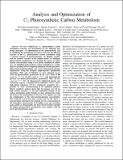Analysis and Optimization of C[subscript 3] Photosynthetic Carbon Metabolism
Author(s)
Stracquadanio, Giovanni; Umeton, Renato; Papini, Alessio; Nicosia, Giuseppe; Lio, Pietro
DownloadNicosia-BIBE10.pdf (176.1Kb)
PUBLISHER_POLICY
Publisher Policy
Article is made available in accordance with the publisher's policy and may be subject to US copyright law. Please refer to the publisher's site for terms of use.
Terms of use
Metadata
Show full item recordAbstract
We have studied the C[subscript 3] photosynthetic carbon metabolism centering our investigation on the following four design principles. (1) Optimization of the photosynthetic rate by modifying the partitioning of resources between the different enzymes of the C[subscript 3] photosynthetic carbon metabolism using a constant amount of protein-nitrogen. (2) Identify sensitive and less sensitive enzymes of the studied model. (3) Maximize photosynthetic productivity rate through the choice of robust enzyme concentrations using a new precise definition of robustness. (4) Modeling photosynthetic carbon metabolism as a multiobjective problem of two competing biological selection pressures: light-saturated photosynthetic rate versus total protein-nitrogen requirement. Using the designed single-objective optimization algorithms, PAO and A-CMA-ES, we have obtained an increase in photosynthetic productivity of the 135% from 15.486 μmol m[superscript -2] s[superscript -1] to 36.382 μmol m[superscript -2] s[superscript -1], and improving the previous best-found photosynthetic productivity value (27.261 μmol m[superscript -2] s[superscript -1], 76% of enhancement). Optimized enzyme concentrations express a maximal local robustness (100%) and a high global robustness (97.2%), satisfactory properties for a possible "in vitro" manufacturing of the optimized pathway. Morris sensitivity analysis shows that 11 enzymes over 23 are high sensitive enzymes, i.e., the most influential enzymes of the carbon metabolism model. Finally, we have obtained the tradeoff between the maximization of the leaf CO[subscript 2] uptake rate and the minimization of the total protein-nitrogen concentration. This trade-off search has been carried out for the three c[subscript i] concentrations referring to the estimate of CO[subscript 2] concentration in the atmosphere characteristic of 25 million years ago, nowadays and in 2100 a.C. Remarkably, the three Pareto frontiers identify the highest photosynthetic- - productivity rates together with the fewest protein-nitrogen usage.
Date issued
2010-05Department
Massachusetts Institute of Technology. Department of Biological EngineeringJournal
Proceedings of the 2010 IEEE International Conference on BioInformatics and BioEngineering
Publisher
Institute of Electrical and Electronics Engineers (IEEE)
Citation
Stracquadanio, Giovanni, Renato Umeton, Alessio Papini, Pietro Liò, and Giuseppe Nicosia. “Analysis and Optimization of C3 Photosynthetic Carbon Metabolism.” 2010 IEEE International Conference on BioInformatics and BioEngineering (2010).
Version: Author's final manuscript
ISBN
978-1-4244-7494-3